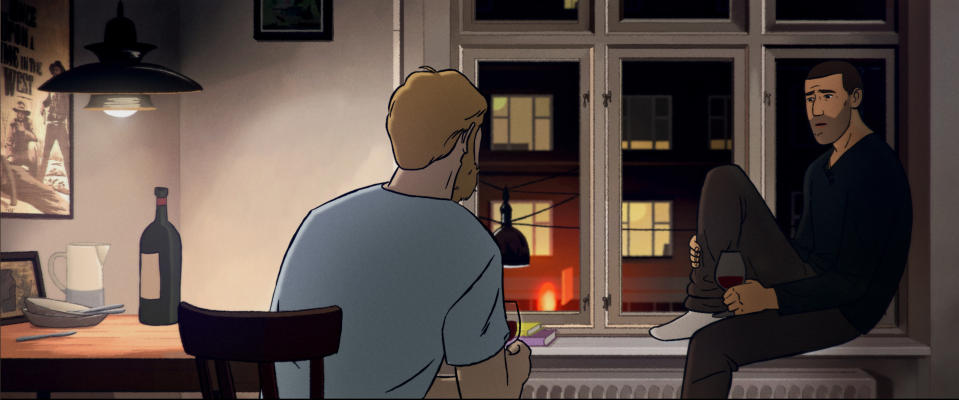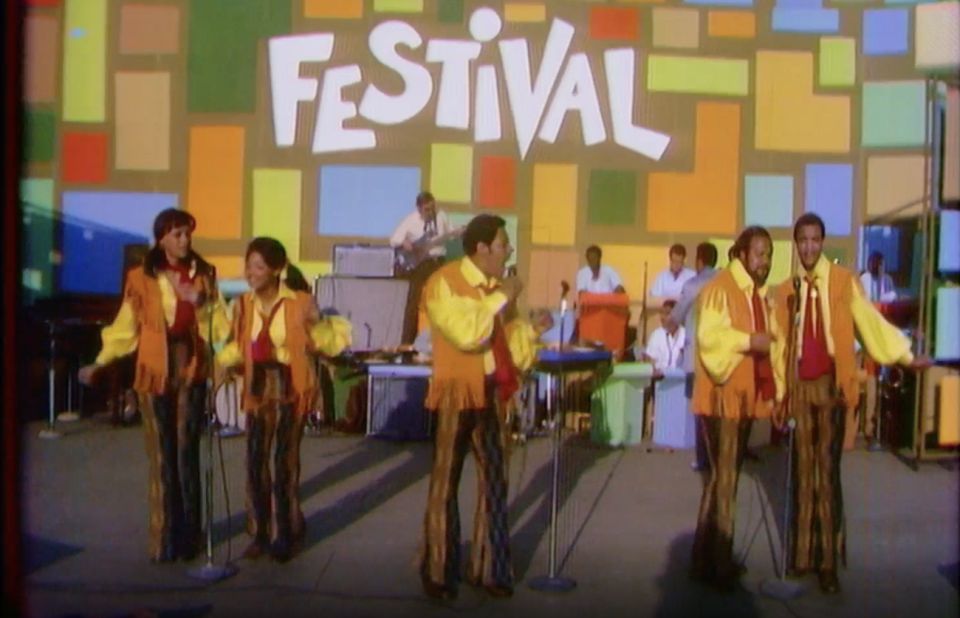No Documentary Has Been Nominated for Best Picture, but ‘Flee’ and ‘Summer of Soul’ Should Change That

- Oops!Something went wrong.Please try again later.
- Oops!Something went wrong.Please try again later.
Documentaries are often among the best movies of the year, but in 93 years of Oscar ceremonies, no documentary has ever been nominated for Best Picture. Many documentaries campaign heavily for Best Original Song, and six documentaries have been nominated in the category over the past decade. “Honeyland” and “Collective” received nominations for Best International Feature Film, but campaigns for “Hoop Dreams” and “Fahrenheit 9/11” came up short.
The oversight raises major questions about the way the Academy Awards tend to prioritize conventional narratives over non-fiction, and whether that distinction has any merit in the first place. “What the fuck is a picture in a Best Picture race? I don’t know even know what that means,” said veteran documentary executive Sheila Nevins, a no-nonsense advocate for the form who produced over 1,000 documentaries at HBO prior to joining MTV Studios. “A best picture of what? There is no rule that says anything about reality versus reenactment.”
More from IndieWire
Behind the Mic and in Front of the Camera, Billie Eilish Became a Movie Star in 2021
'Adrienne' Review: A Heartbreaking Love Letter to Director Adrienne Shelly Showcases Her Bright Life
This year, two of the biggest crowdpleasers are Sundance-winning documentaries, both of which have distributors with major awards season bonafides. Danish director Jonas Rasmussen Poher’s “Flee” (Neon) is an animated odyssey that tracks the experiences of a gay Afghan refugee sharing his story; the movie utilizes technology and creative ingenuity to protect the subject’s identity and creates a remarkable platform for the refugee experience. “Summer of Soul” (Searchlight), the directorial debut of The Roots drummer Ahmir “Questlove” Thompson, rescues the jubilant footage of the under-appreciated 1969 Harlem Cultural Festival, canonizing a seminal moment in Black artistry on the platform it deserves.
At recent screenings, these startling achievements have found appreciative crowds crammed with Academy members, and they both show potential to break out of the Best Documentary category. As the Danish Oscar submission, “Flee” is a contender for Best International Feature in addition to Best Animated Feature, while “Summer of Soul” could be the first documentary since “Hoop Dreams” to land a Best Editing nomination. (Thelma Schoonmaker was the first with “Woodstock,” an obvious precedent for the archival-based musical celebration that unfurls in “Summer of Soul.”)

Stephen Lovekin/Variety/REX/Shutterstock
Momentum in these categories could mean support across multiple Academy branches, but the idea of voting for documentaries as Best Picture remains so foreign to many voters that many of them say they’ve never even considered the oversight. “I haven’t thought much about it,” said Frederick Wiseman, the 91-year-old documentary legend who was given an honorary Oscar in 2016. “From a filmmaking point of view, there’s no reason that a documentary can’t be as good, or interesting, or important as a fiction film.”
With the Best Picture category open to 10 contenders this year, Nevins said it’s high time that voters considered the porous distinction between documentaries and fiction. “Maybe the word itself has to gain greater dignity,” said Sheila Nevins. “It needs to become a five-star word.”
The debate opens up a rabbit hole of semantics. “OK, so ‘Nomadland,’” Nevins said. “Was that a documentary or a narrative? It has real people doing real things in it. Do we really need to make a differentiation between different ways of telling stories?”
What’s Taking So Long?
Academy voters have had no shortage of opportunity to vote for documentaries. The Academy’s official “Reminder List” for 2020, which details all qualifying titles in “non-specialized” categories such as Best Picture, contained at least 84 documentaries, including “All In: The Fight for Democracy,” “Bloody Nose, Empty Pockets,” and “Gunda.”
Like all awards candidates, top contenders benefit from costly campaigns and savvy whisperers. There are other factors at work as well. “People compartmentalize films to make it easier when it comes around to voting,” said Edgar Wright, a member of the directors branch. In addition to his latest genre-shifting effort “Last Night in Soho,” Wright’s music documentary “The Sparks Brothers” marked his first foray into non-fiction this year.
“I’m shocked there’s never been a documentary nominated for Best Picture,” he said. “I don’t think there’s any malice intended to the different forms, but I don’t really know how that changes.”
Last year, Wright opted into the early voting process for Best International Feature — available to all members — and said he watched 45 features during that time. Only documentary branch members get that opportunity for the Best Documentary shortlist. Some Academy insiders suggest that changing these rules might help position documentaries on even ground.

Fine Line Features
Previous efforts to position documentaries in the Best Picture category include Steve James’ acclaimed 1994 epic about aspiring NBA stars “Hoop Dreams.” It was among the top five highest-grossing documentaries of all time when distributor Fine Line Features began talking about a Best Picture bid. Ultimately, the movie didn’t even land a Best Documentary nomination (though it did score a surprising nod in the Best Editing category, where only 1969’s “Woodstock” had been nominated before).
“Obviously, it was exciting to think that might happen, but I didn’t really believe that it would,” James said. “It turned out that getting nominated for documentary was tough enough.” At the time, he heard a rumor that “Hoop Dreams” came closer to a Best Picture nomination than it did in the Best Documentary category. “In terms of awards in general, it’s great to win and get nominated,” he said. “It’s part of validating the work when that happens. And if you don’t, it feels like bullshit.”
The Best Documentary snub for “Hoop Dreams” — along with those for “Roger & Me,” “The Thin Blue Line,” and “Paris Is Burning” — stimulated a broader conversation about problems with the category. “We violated the two rules of documentary filmmaking,” Moore said in 1989, after “Roger & Me” was left out of contention. “Our film is entertaining and people are going to see it.” In 2003, Moore became the first documentarian to secure a WGA award for Best Adapted Screenplay for “Bowling for Columbine”; a year later, he mounted his own Best Picture campaign for “Fahrenheit 9/11” after the movie became the highest-grossing documentary of all time. The move also came out of necessity: Moore rushed “Fahrenheit 9/11” to a broadcast release before the fall in a bid to sway the 2004 presidential election, disqualifying it from the Best Documentary category.
In 1995, “Hoop Dreams” fallout led to the Academy adding a second panel of judges in New York to participate in the nominating process with judges in Los Angeles. But it wasn’t until 2012 that Moore himself, as part of the Board of Governors for the Documentary Branch, successfully pushed through rules that allowed the entire documentary branch to vote for the nominees. “I figured the simplest and easiest way to prevent this from happening any further is to just let everyone vote,” Moore told The New York Times.

ASSOCIATED PRESS
Today, all Academy branches (other than members-at-large) vote for Best Picture. There’s nothing that stops the inclusion of documentaries other than being aware and willing. “You have to hear about a film like five times before deciding to see it,” said producer and filmmaker Carl Deal, who was nominated for 2008’s “Trouble the Water” and produced several films for Moore. “Realistically, most people don’t have time to watch 300-odd documentaries in a two- or three-month period. I guess that’s where the better-resourced films get on people’s radars.”
In 2020, the momentum behind eventual Best Documentary winner “Free Solo” led many to speculate that it came close to a Best Picture nomination. With its $20 million box office gross and actors like Tom Hanks jockeying for it behind the scenes, the theory is more than plausible. And with documentaries continuing to find substantial audiences on major streaming platforms, another contender could readily build on that same potential.
As money pours into the documentary space, some documentarians said they believe a Best Picture nomination is imminent. “It’s happening naturally,” said Davis Guggenheim, who won Best Documentary for “An Inconvenient Truth” and oversees the formidable documentary production company Concordia. “People are turning to documentaries not just for greater meaning, but also adventurous creative ambition. There have been a few times in recent years where I believe the best films of the year, by all standards, was a documentary.”
Escaping the Niche
Some documentary branch members say that documentary filmmakers are marginalized within the Academy itself. Few documentary filmmakers are members of the far more influential directors branch, although the documentary branch is more expansive in its membership and includes both executives and craftspeople who work on documentaries. The newly opened Academy Museum celebrates major directors like Pedro Almodovar and Hayao Miyazaki, but the permanent collection on display includes only a handful of references to documentaries. “We’re kind of bastardized within the Academy,” one documentary veteran said. “That’s why we don’t get those other nominations. We aren’t part of those branches and communities.”
Filmmaker Amy Berg, who was nominated for Best Documentary in 2007 for “Deliver Us From Evil,” said she had been lobbying for a documentary editing category. “It’s a shame we only have one category,” she said. She also believes that the Best Documentary category should include 10 nominees, like Best Picture. In theory, this could position more documentaries to contend for other categories and create a clearer pathway for Best Picture.
Recent Oscar progress for documentaries relied on specific circumstances. For “Honeyland” to become the first documentary simultaneously nominated for Best International Feature in 2019, it also had to be the North Macedonian submission. Neon, the distributor that secured that breakthrough, also pioneered the astonishing Best Picture campaign for “Parasite” one year later. Now, the company is hoping to shatter another barrier with “Flee,” after acquiring the movie following its Sundance debut in January. “I think the idea that it’s possible is there,” said Neon CEO Tom Quinn. “I can’t categorize films into certain genres that make one seem less cinematic than the other. I think we benefit from being completely agnostic on this.”

Of course, it’s a lot more complicated than that. For “Flee,” Neon is betting on a trifecta of possibilities. As a contender for Best Documentary and Best International Feature, the movie is making inroads with the animation branch: It won three awards at the venerated Annecy Animation Festival in June, and took home the top prize at the Animation is Film Festival in Hollywood. That would negate the impression that animation voters are resistant to supporting non-fiction. If nominated in both documentary and animation categories, “Flee” would be the first entirely animated documentary to wind up in either category. The campaign is also targeting actors, the Academy’s biggest branch, with the support of executive producer and recent Oscar nominee Riz Ahmed. Meanwhile, with the Afghan refugee crisis continuing to create hardships around the world, “Flee” puts a human face on one of the year’s most pressing humanitarian issues.
The movie tells the story of a man named Amin, Poher’s longtime friend, who finally agrees to discuss his experiences escaping the Taliban in the ’90s from the vantage point of his stable adult life in Copenhagen. The animation provides cover for Amin, but it also deepens the emotional intensity of his story, from the paranoia of life on the streets of Afghanistan to an unsettling stopover in Russia and a harrowing trip across the sea.
Like Ari Folman’s 2008 “Waltz with Bashir,” animation transforms real-life memories into vivid, experiential fragments that transcend the narration’s boundaries. Amin’s repressed sexuality often takes center stage, both in fantasy sequences and a climactic coming-out moment that register as some of the year’s best scenes. “I wanted to figure out how to create his journey through the form itself,” Poher said during an interview in New York. “To be honest, I don’t know what the rules of documentary storytelling are. To me, every story has its form it needs to find.”
The filmmaker added that his subject has been watching the movie’s success from Denmark with great interest, even as he remains committed to anonymity. “He’s lived with this story as a secret for so many years,” Poher said. “It’s been difficult that he can’t talk about the past. Just to have his past and present come together makes him feel more whole.” If that’s not Oscar bait, it should be.
As for “Summer of Soul,” Questlove’s capacity to resurrect the Harlem Cultural Festival through heretofore unseen footage is a rare act of historical correction through art on a grand scale. The drummer combed through 45 hours of material to showcase the likes of a young Steve Wonder, Sly and the Family Stone, Nina Simone and B.B. King for an explosive portrait of Black joy inexplicably overshadowed by Woodstock for generations. The newbie filmmaker said that he was beating himself up for not knowing about the event sooner. “My all-knowing Questloveness should’ve known about this,” he told IndieWire at Sundance, shortly before it won the Grand Jury prize. “All these greats gave a free performance for 300,000 people and it’s nowhere on the internet? Like, that’s impossible!”

Sundance Institute
The movie corrects a disservice done to the material decades ago, when networks rejected the footage for earlier documentary attempts. “Nobody was interested. That’s what gripped me,” Questlove said. “I personally live a life in which musical gatherings define my life.” By watching “Summer of Soul,” the audience gets to live there, too.
“I can’t say I’ve worked on any film that has been as praised as this one,” said Marie Therese Gurgis, an executive producer on the project who has worked on documentaries for over 20 years. “I think the film has had an impact that happens once in a generation.” Searchlight executives declined to comment on the movie’s chances at Best Picture.
Meanwhile, “Free Solo” directors Jimmy Chin and Elizabeth Chai Vasarhelyi are back in the mix with “The Rescue,” their bracing account of the divers who rescued a juvenile Thai soccer team in 2018. The movie won the coveted People’s Choice award for best documentary at TIFF, and later scored an unexpected boost from director Barry Jenkins, who live-tweeted his enthusiastic experience of watching a link to the movie in early October. The word “documentary” didn’t come up once in his emphatic response. Instead, he concluded: “That’s a FANTASTIC movie.”
“Documentary Is a Loaded Word”
The documentary community often has a rigid approach to its own practice. Nevins recalled the backlash she received after producing the miniseries “5 American Handguns – 5 American Kids,” which explores how several innocent children who lost their lives while playing with handguns could have avoided those fates. It relied heavily on reenactments. “How else are you supposed to tell the story? We didn’t have the film of the funeral,” Nevins said. “I don’t have any rules. But apparently there are rules.”
In retrospect, Nevins said she would have liked to see a stronger campaign for Best Picture or Best Director behind last year’s Netflix release “Dick Johnson Is Dead,” in which filmmaker Kirsten Johnson imagines her still-living father’s demise. “That would be looked down on by a lot of doc purists because of the reenactments,” she said. “But as docs break out of their mold, do they have a home in these other categories?” Netflix, one of the most aggressive awards campaigners out there, could make the case. “If you’ve got the money to spend,” Nevins said, “spread it around.”

Netflix
Wiseman, whose last movie was 2020’s four-and-a-half hour “City Hall,” sounded nonplussed. “I was very pleased to get the honorary Oscar because it’s public recognition that some people like my films. I think the people who put the effort in recognized that I hadn’t been nominated and I probably wouldn’t be,” he said. “But whole thing is politics, that’s all it is. It’s a political contest. Basically, the people that spend the money to solicit the votes win. It has nothing to do with merit. I don’t know that anybody makes any claim to that.”
Wiseman’s filmmaking career took off with 1967’s “Titicut Follies,” and he grew used to seeing his work ostracized. “What’s called documentary filmmaking in the eyes of some people has always been a second-class form,” he said. “If there was no documentary category, the chances of documentaries getting any recognition at all would be next to nil. On the other hand, if the measure were quality — which it isn’t — then there’s no reason why a documentary couldn’t compete with a fiction film.”
He wasn’t convinced that the stigma associated with the documentaries had gone away. “When I’m asked what I do, I say that I make movies,” he said. “Documentary is a loaded word.”
Best of IndieWire
2021 Emmys Winners List: 'Ted Lasso,' 'The Crown,' and 'The Queen's Gambit' Lead the Night
2021 Emmy Predictions: Who Will Win at the Primetime Emmy Awards?
Emmy Predictions: Best Limited Series — Was It 'The Queen's Gambit' All Along?
Sign up for Indiewire's Newsletter. For the latest news, follow us on Facebook, Twitter, and Instagram.


